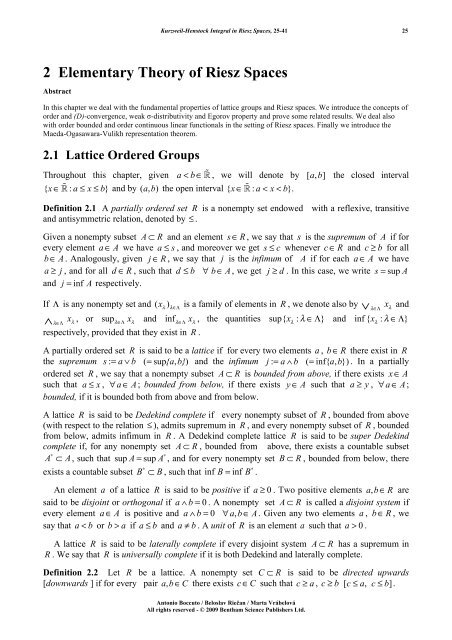Kurzweil-Henstock Integral in Riesz spaces - Bentham Science
Kurzweil-Henstock Integral in Riesz spaces - Bentham Science
Kurzweil-Henstock Integral in Riesz spaces - Bentham Science
Create successful ePaper yourself
Turn your PDF publications into a flip-book with our unique Google optimized e-Paper software.
<strong>Kurzweil</strong>-<strong>Henstock</strong> <strong>Integral</strong> <strong>in</strong> <strong>Riesz</strong> Spaces, 25-41 25<br />
2 Elementary Theory of <strong>Riesz</strong> Spaces<br />
Abstract<br />
In this chapter we deal with the fundamental properties of lattice groups and <strong>Riesz</strong> <strong>spaces</strong>. We <strong>in</strong>troduce the concepts of<br />
order and (D)-convergence, weak -distributivity and Egorov property and prove some related results. We deal also<br />
with order bounded and order cont<strong>in</strong>uous l<strong>in</strong>ear functionals <strong>in</strong> the sett<strong>in</strong>g of <strong>Riesz</strong> <strong>spaces</strong>. F<strong>in</strong>ally we <strong>in</strong>troduce the<br />
Maeda-Ogasawara-Vulikh representation theorem.<br />
2.1 Lattice Ordered Groups<br />
Throughout this chapter, given a< b<br />
R , we will denote by [ ab , ] the closed <strong>in</strong>terval<br />
{ x R : a xb} and by ( ab , ) the open <strong>in</strong>terval { x R : a< x< b}.<br />
Def<strong>in</strong>ition 2.1 A partially ordered set R is a nonempty set endowed with a reflexive, transitive<br />
and antisymmetric relation, denoted by .<br />
Given a nonempty subset A R and an element s R,<br />
we say that s is the supremum of A if for<br />
every element a A we have a s,<br />
and moreover we get s c whenever c R and c b for all<br />
b A.<br />
Analogously, given j R,<br />
we say that j is the <strong>in</strong>fimum of A if for each a A we have<br />
a j,<br />
and for all d R,<br />
such that d b b A,<br />
we get j d . In this case, we write s = sup A<br />
and j = <strong>in</strong>f A respectively.<br />
If is any nonempty set and ( x) is a family of elements <strong>in</strong> R , we denote also by x and<br />
x , or sup x<br />
and <strong>in</strong>f x,<br />
the quantities sup{ x : } and <strong>in</strong>f { x : }<br />
respectively, provided that they exist <strong>in</strong> R .<br />
A partially ordered set R is said to be a lattice if for every two elements a , b R there exist <strong>in</strong> R<br />
the supremum s:= a b ( = sup {a, b} ) and the <strong>in</strong>fimum j:= a b ( = <strong>in</strong>f{ ab , }) . In a partially<br />
ordered set R , we say that a nonempty subset A R is bounded from above, if there exists x A<br />
such that a x,<br />
a A;<br />
bounded from below, if there exists y A such that a y,<br />
a A;<br />
bounded, if it is bounded both from above and from below.<br />
A lattice R is said to be Dedek<strong>in</strong>d complete if every nonempty subset of R , bounded from above<br />
(with respect to the relation ), admits supremum <strong>in</strong> R , and every nonempty subset of R , bounded<br />
from below, admits <strong>in</strong>fimum <strong>in</strong> R . A Dedek<strong>in</strong>d complete lattice R is said to be super Dedek<strong>in</strong>d<br />
complete if, for any nonempty set A R,<br />
bounded from above, there exists a countable subset<br />
<br />
A A,<br />
such that sup A= sup A , and for every nonempty set B R,<br />
bounded from below, there<br />
<br />
exists a countable subset B B,<br />
such that <strong>in</strong>f B= <strong>in</strong>f B .<br />
An element a of a lattice R is said to be positive if a 0 . Two positive elements ab , R are<br />
said to be disjo<strong>in</strong>t or orthogonal if a b=<br />
0 . A nonempty set A R is called a disjo<strong>in</strong>t system if<br />
every element a A is positive and a b=<br />
0 ab , A.<br />
Given any two elements a , b R,<br />
we<br />
say that a< b or b> a if a b and a b.<br />
A unit of R is an element a such that a > 0 .<br />
A lattice R is said to be laterally complete if every disjo<strong>in</strong>t system A R has a supremum <strong>in</strong><br />
R . We say that R is universally complete if it is both Dedek<strong>in</strong>d and laterally complete.<br />
Def<strong>in</strong>ition 2.2 Let R be a lattice. A nonempty set C R is said to be directed upwards<br />
[downwards ] if for every pair ab , C there exists c C such that c a,<br />
c b [c a,<br />
c b]<br />
.<br />
Antonio Boccuto / Beloslav Riean / Marta Vrábelová<br />
All rights reserved - © 2009 <strong>Bentham</strong> <strong>Science</strong> Publishers Ltd.

















